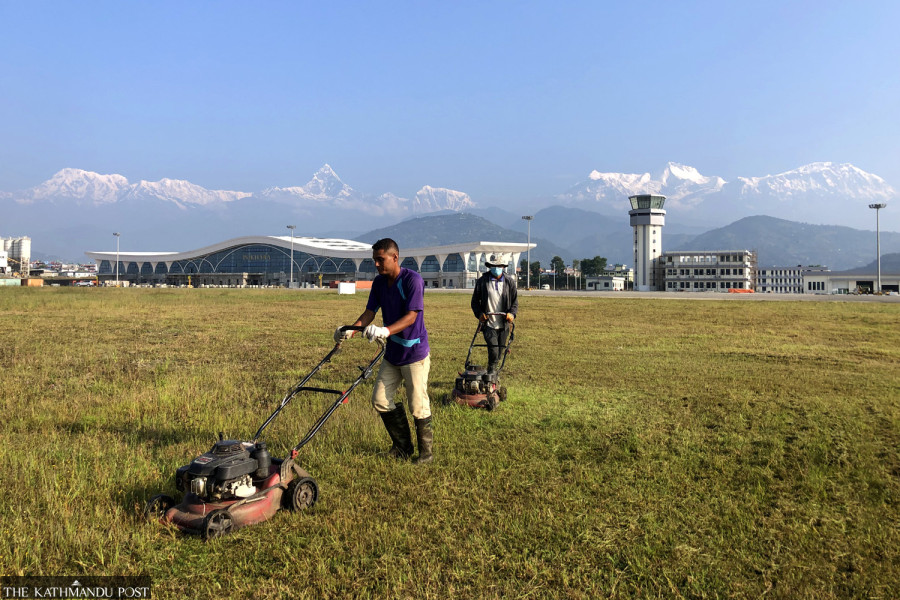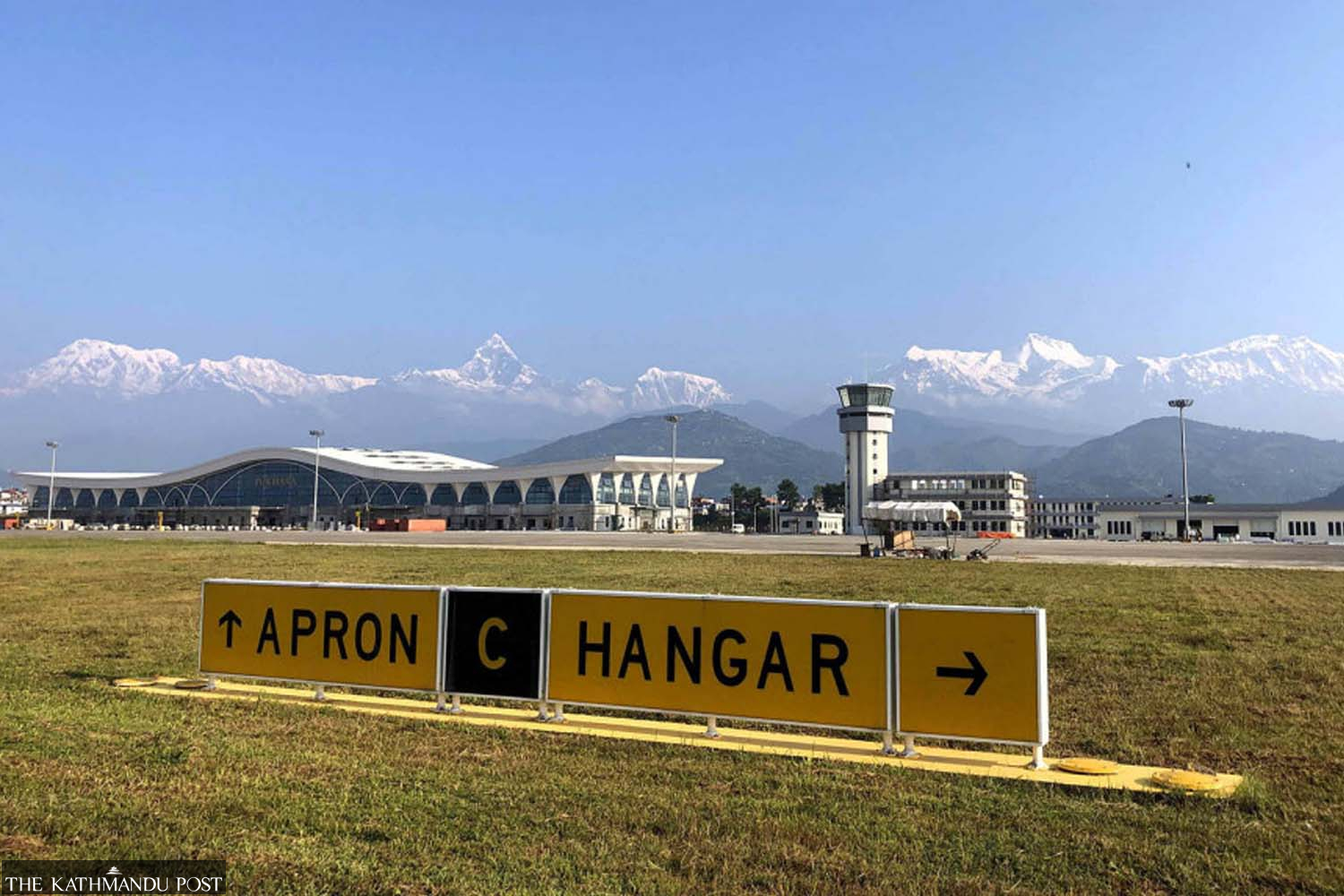Money
January 1 opening of Pokhara airport, insiders say, is a flight of fancy
There are many environmental, technical and social issues that need to be addressed before flights can be cleared, which may take months.
Sangam Prasain
Airplane pilots have found out about bird hazards in Pokhara the hard way. Once in the mid-1990s, a Nepal Airlines Twin Otter had just taken off for Jomsom when a big bird slammed into the windshield, shattering the glass and splattering blood all over the cockpit.
The broken body of a white vulture, weighing 7-8 kg, lay half inside and half outside the cockpit, as the stunned crew moved to land the aircraft.
The Twin Otter was flying over Phewa Lake, and Captain Dipayal Sherchan was temporarily blinded by blood running down his face.
The co-pilot Rajan Manandhar, now a retired captain, said, “It was my second flight. I was assisting Captain Sherchan. Just after the bird strike, Captain Sherchan became blinded. He couldn't see anything. Fearing that the plane could stall and fall, I instantly took command.”
The Twin Otter made an emergency landing with the giant vulture stuck in the windshield, and Captain Sherchan clutching the dead bird so it wouldn't get sucked into the engines.
“I told Captain Sherchan to hold the vulture until we landed to prevent a bird ingestion, which would have caused another problem,” Manandhar told the Post. “We made an emergency landing with a broken windshield and a huge bird hanging from it.”
Pokhara will now have an international airport, the third such facility in the country. The tourist hotspot, which lies between two rivers, the Bijayapur and the Seti, makes a perfect habitat for birds. Excellent for sightseers, of course, but a terror for pilots.
And it doesn't help that Pokhara Metropolitan City maintains a landfill site on the banks of the Seti River, about 1.5 km from the new airport, which attracts large birds of prey.
As per the Civil Aviation Rule 2002, the landfill needs to be relocated. The rule says no person shall be allowed to store and dump solid waste in the open within a 3 km radius of an airport.
"The landfill makes the new airport vulnerable to bird strikes," said Manandhar.
The government has announced that Pokhara international airport will open on January 1, 2023, but there are many environmental, technical and social issues that need to be addressed before flights can be cleared, which may take months, say insiders.
Tasks related to relocating the landfill site, flattening the hills on the approach and testing the new facility are moving at a snail's pace. The deadline for the planned inauguration is approaching.
Plans to relocate the landfill site, which is near the airport and is deemed a safety hazard, look unrealistic with only four months remaining, insiders say.
“Without relocating the landfill site, flying to the new airport will be dangerous,” said Manandhar.
Binesh Munankarmi, chief of the airport project, says the infrastructure is complete.
The government took a $215.96 million soft loan from China EXIM Bank in March 2016 to pay for the project, which was implemented on an engineering procurement and construction model.
The new airport is the gateway to the Annapurna Circuit, a world famous trekking route, and is located at Chinnedanda, 3 km east of the existing domestic airport.
The runway of Pokhara International Airport is 45 metres wide and 2,500 metres long, and has an east-west orientation. A 1,200-metre-long and 23-metre-wide taxiway connects the runway with the parking bays, hangars and terminals.
Pokhara possesses seven lakes, offers spectacular views of mountain ranges including Annapurna and Dhaulagiri, and is the jumping off point to famous religious places like Muktinath and Jomsom.
In 2019, the domestic airport served more than 700,000 passengers, making it the second busiest airport in Nepal after Kathmandu.
“We are planning a calibration flight in October,” Munankarmi said. In this process, a calibration aircraft is generally used to inspect the communication or navigational instrument to ensure that they work accurately and precisely.
But until the rubbish dump is cleared, the airport remains off limits. Munankarmi says they are confident of starting flights on January 1.
“Pokhara Metropolitan City has assured us that they will relocate the landfill site—if not permanent, temporarily,” he said. “We have been cleared to cover the landfill site with soil. We will be using the soil removed from Ritthepani Hill.”

Around 90,000 tonnes of soil and stones will have to be trucked away while flattening the hilltop, according to a supplementary environmental impact assessment report.
The 817-metre-high Ritthepani Hill, which lies just across the Bijayapur River, poses an approach hazard and needs to be flattened.
A 2-hectare forest covers the hill which is 1.35 km from the eastern end of the runway. The project needs to lop off the tops of two hills at Ritthepani by 40 and 12 metres respectively.
The Ministry of Forests and Environment has cleared the project to flatten the hill tops. “The task will be completed by October, before the calibration flight is done,” said Munankarmi.
But with Covid-19 cases rising in many cities in China which has led the northern neighbour to impose lockdowns, the work of calibrating the airport equipment may be delayed, some project officials say.
“Until now, everything is on track. We have not been informed about the development by Chinese officials,” said Munankarmi.
Apart from the concerns raised by a Covid surge in China, insiders say the slow pace at which Pokhara Metropolitan City has been moving to relocate the landfill site has created another worry.
“Without clearing the landfill site, no one will fly to the new airport,” insiders say.
In March, Chinese Foreign Minister Wang Yi during his visit to Nepal handed over the symbolic key of the country’s third international airport before its construction was completed. It was a gesture that the Chinese-funded airport would be ready for operations before July 10, the extended deadline given to the project contractor.
The completion deadline, however, has been extended for a second time by six months to December 31, as calibration flights and testing of communication and navigation equipment are yet to be done.
Khem Raj Acharya, personal aide to Pokhara Mayor Dhan Raj Acharya, said they were working on a war footing to deal with the landfill. “Obviously, we are running late. The relocation of the landfill site should have been completed two years ago,” he said.
According to Acharya, the city fathers are weighing two options. First, install a solid waste recycling plant. The place, however, has not been determined. Second, relocate the landfill site. Officials have proposed Ward 33 as a potential landfill site.
“The metropolitan city will finalise its plan within the next two weeks. If the plan materialises, the plant will be installed within 120 days,” said Acharya. “We are confident of completing the process by January 1, the date set for the first flight at the new airport.”
Pokhara Valley is a splendid place for birds due to its combination of Seti Canyon and marshy lakes along with dense forests and flat plains that provide a fine habitat for diverse species, according to the environmental impact assessment report.
The recorded bird species in the areas are kingfisher, barbet, drongo, woodpecker, babbler, flowerpecker, flycatcher, egret and bulbul, among others. The birds are residential as well as migratory. There are at least 108 species of birds in and around the new airport.
Acharya says they have been informed by experts that relocating the bird habitat may take at least six months. “We are also planning to establish a few vulture restaurants to conserve these birds after the existing landfill site is covered with soil.”
Birendra Dev Bharati, chief administrative officer of Pokhara Metropolitan City, said the process of relocating the landfill site, though difficult and complicated, will be completed on time.
“We have planned to install a solid waste processing machine. It’s under study,” he said.
According to Bharati, a team from Pokhara has been to Dharan to study the plant there. The waste processing plant in Dharan was inaugurated in January.
The waste processing plant has a daily capacity of 50 tonnes and produces gas and manure. The plant generates 2 tonnes of gas daily.
“After Dharan, another team will be travelling to New Delhi, India to observe a larger solid waste processing plant this week,” said Bharati. “After the team submits its report, we will reach a decision to install the plant.”
Officials say it may take five to six months to complete the tendering process and install the plant if things go as planned.
Pokhara has seen fast urbanisation, and it has become one of the most crowded cities in the country. The daily waste going to the landfill site is already over 200 tonnes.
“We are looking for a long-term plan to manage waste in Pokhara. The processing plant will reduce the waste volume as well,” he said. “The way urbanisation is taking place in Pokhara, if decisions are not taken wisely, in another few years, we will require another landfill site.”
Bharati says they have settled on Ward 33 as the location for the new landfill, where the solid waste processing plant will be installed.
In 2012, Pokhara residents conducted a relay hunger strike lasting months demanding that a new international airport be built. They even forced the domestic airport to shut down as part of the demonstration.
“We hope we will meet the target to see the first flight landing at the new airport. It’s a national pride project,” said Bharati.
But unless the flights really start, the said date to launch the airport, some say, is just a flight of fancy.




 10.12°C Kathmandu
10.12°C Kathmandu














